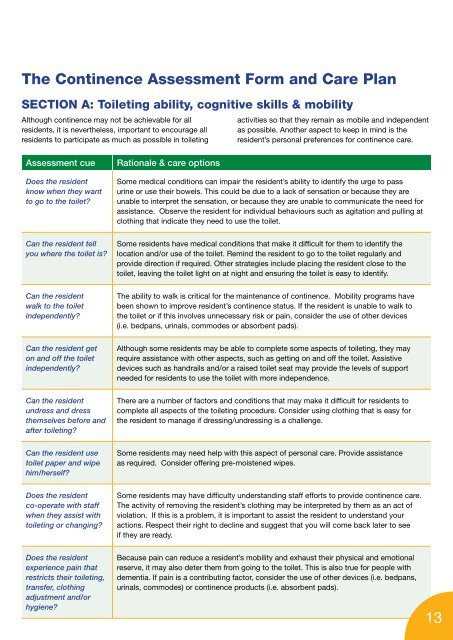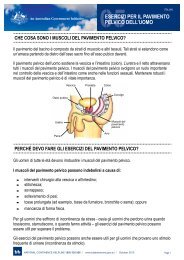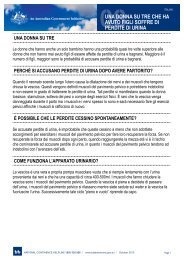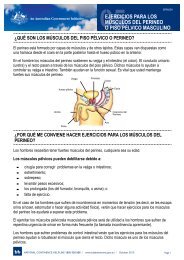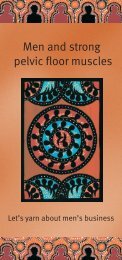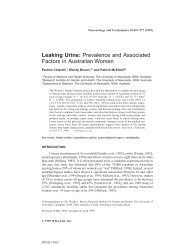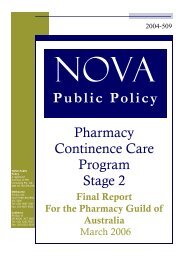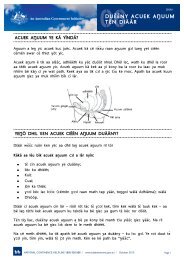Continence Tools for Residential Aged Care - Bladder and Bowel ...
Continence Tools for Residential Aged Care - Bladder and Bowel ...
Continence Tools for Residential Aged Care - Bladder and Bowel ...
Create successful ePaper yourself
Turn your PDF publications into a flip-book with our unique Google optimized e-Paper software.
The <strong>Continence</strong> Assessment Form <strong>and</strong> <strong>Care</strong> Plan<br />
SECTION A: Toileting ability, cognitive skills & mobility<br />
Although continence may not be achievable <strong>for</strong> all<br />
residents, it is nevertheless, important to encourage all<br />
residents to participate as much as possible in toileting<br />
Assessment cue Rationale & care options<br />
Does the resident<br />
know when they want<br />
to go to the toilet?<br />
Can the resident tell<br />
you where the toilet is?<br />
Can the resident<br />
walk to the toilet<br />
independently?<br />
Can the resident get<br />
on <strong>and</strong> off the toilet<br />
independently?<br />
Can the resident<br />
undress <strong>and</strong> dress<br />
themselves be<strong>for</strong>e <strong>and</strong><br />
after toileting?<br />
Can the resident use<br />
toilet paper <strong>and</strong> wipe<br />
him/herself?<br />
Does the resident<br />
co-operate with staff<br />
when they assist with<br />
toileting or changing?<br />
Does the resident<br />
experience pain that<br />
restricts their toileting,<br />
transfer, clothing<br />
adjustment <strong>and</strong>/or<br />
hygiene?<br />
activities so that they remain as mobile <strong>and</strong> independent<br />
as possible. Another aspect to keep in mind is the<br />
resident’s personal preferences <strong>for</strong> continence care.<br />
Some medical conditions can impair the resident’s ability to identify the urge to pass<br />
urine or use their bowels. This could be due to a lack of sensation or because they are<br />
unable to interpret the sensation, or because they are unable to communicate the need <strong>for</strong><br />
assistance. Observe the resident <strong>for</strong> individual behaviours such as agitation <strong>and</strong> pulling at<br />
clothing that indicate they need to use the toilet.<br />
Some residents have medical conditions that make it difficult <strong>for</strong> them to identify the<br />
location <strong>and</strong>/or use of the toilet. Remind the resident to go to the toilet regularly <strong>and</strong><br />
provide direction if required. Other strategies include placing the resident close to the<br />
toilet, leaving the toilet light on at night <strong>and</strong> ensuring the toilet is easy to identify.<br />
The ability to walk is critical <strong>for</strong> the maintenance of continence. Mobility programs have<br />
been shown to improve resident’s continence status. If the resident is unable to walk to<br />
the toilet or if this involves unnecessary risk or pain, consider the use of other devices<br />
(i.e. bedpans, urinals, commodes or absorbent pads).<br />
Although some residents may be able to complete some aspects of toileting, they may<br />
require assistance with other aspects, such as getting on <strong>and</strong> off the toilet. Assistive<br />
devices such as h<strong>and</strong>rails <strong>and</strong>/or a raised toilet seat may provide the levels of support<br />
needed <strong>for</strong> residents to use the toilet with more independence.<br />
There are a number of factors <strong>and</strong> conditions that may make it difficult <strong>for</strong> residents to<br />
complete all aspects of the toileting procedure. Consider using clothing that is easy <strong>for</strong><br />
the resident to manage if dressing/undressing is a challenge.<br />
Some residents may need help with this aspect of personal care. Provide assistance<br />
as required. Consider offering pre-moistened wipes.<br />
Some residents may have difficulty underst<strong>and</strong>ing staff ef<strong>for</strong>ts to provide continence care.<br />
The activity of removing the resident’s clothing may be interpreted by them as an act of<br />
violation. If this is a problem, it is important to assist the resident to underst<strong>and</strong> your<br />
actions. Respect their right to decline <strong>and</strong> suggest that you will come back later to see<br />
if they are ready.<br />
Because pain can reduce a resident’s mobility <strong>and</strong> exhaust their physical <strong>and</strong> emotional<br />
reserve, it may also deter them from going to the toilet. This is also true <strong>for</strong> people with<br />
dementia. If pain is a contributing factor, consider the use of other devices (i.e. bedpans,<br />
urinals, commodes) or continence products (i.e. absorbent pads).<br />
13


